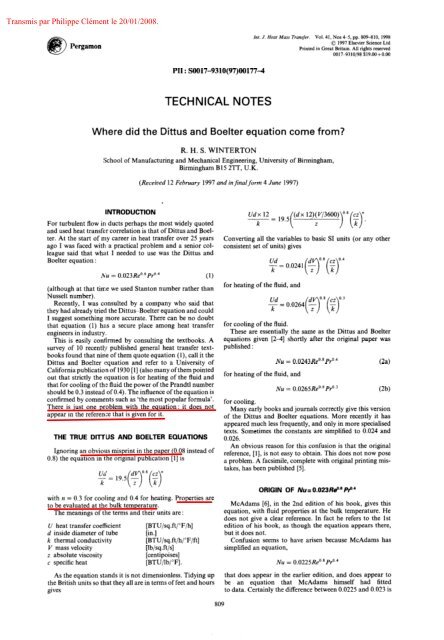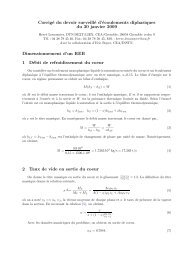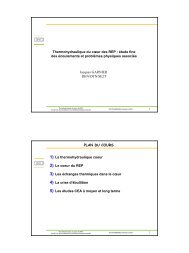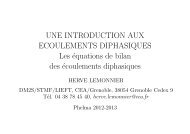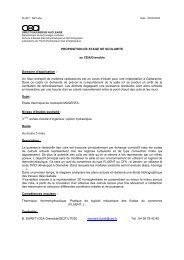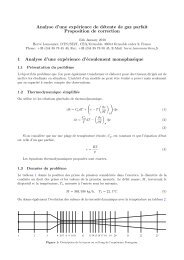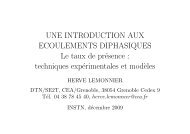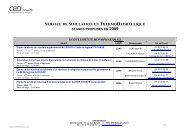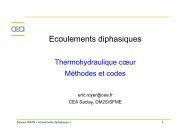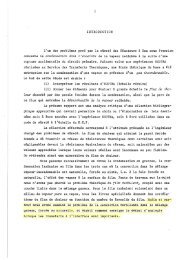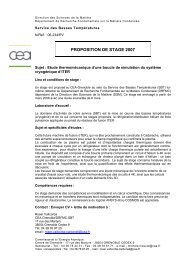Where did the Dittus and Boelter equation come
Where did the Dittus and Boelter equation come
Where did the Dittus and Boelter equation come
You also want an ePaper? Increase the reach of your titles
YUMPU automatically turns print PDFs into web optimized ePapers that Google loves.
Pergamon<br />
PI1 : soo17-9310(97)001774<br />
TECHNICAL NOTES<br />
hr. J. Hear Mass Trm/er. Vol. 41, Nos 45, pp. 80%8lO, 1998<br />
0 1997 Elswier Science Ltd<br />
Printed in Great Britain. All rights reserved<br />
0017-9310/98 $19.OO+O.CMl<br />
<strong>Where</strong> <strong>did</strong> <strong>the</strong> <strong>Dittus</strong> <strong>and</strong> <strong>Boelter</strong> <strong>equation</strong> <strong>come</strong> from?<br />
R. H. S. WINTERTON<br />
!lchool of Manufacturing <strong>and</strong> Mechanical Engineering, University of Birmingham,<br />
Birmingham B 15 2TT, U.K.<br />
INTRODUCTION<br />
For turbulent flow in ducts perhaps <strong>the</strong> most widely quoted<br />
<strong>and</strong> used heat transfe:r correlation is that of <strong>Dittus</strong> <strong>and</strong> Boel-<br />
ter. At <strong>the</strong> start of my career in heat transfer over 2.5 years<br />
ago I was faced with a practical problem <strong>and</strong> a senior col-<br />
league said that what I needed to use was <strong>the</strong> <strong>Dittus</strong> <strong>and</strong><br />
<strong>Boelter</strong> <strong>equation</strong> :<br />
hu = 0.023Re0~*Pr” 4 (1)<br />
(although at that time we used Stanton number ra<strong>the</strong>r than<br />
Nusselt number).<br />
Recently, I was consulted by a company who said that<br />
<strong>the</strong>y had already tried <strong>the</strong> <strong>Dittus</strong>-<strong>Boelter</strong> <strong>equation</strong> <strong>and</strong> could<br />
I suggest something more accurate. There can be no doubt<br />
that <strong>equation</strong> (1) has a secure place among heat transfer<br />
engineers in industry.<br />
This is easily conlirmed by consulting <strong>the</strong> textbooks. A<br />
survey of 10 recently published general heat transfer textbooks<br />
found that nine of <strong>the</strong>m quote <strong>equation</strong> (l), call it <strong>the</strong><br />
<strong>Dittus</strong> <strong>and</strong> <strong>Boelter</strong> <strong>equation</strong> <strong>and</strong> refer to a University of<br />
California publication of 1930 [l] (also many of <strong>the</strong>m pointed<br />
out that strictly <strong>the</strong> <strong>equation</strong> is for heating of <strong>the</strong> fluid <strong>and</strong><br />
that for cooling of ths: fluid <strong>the</strong> power of <strong>the</strong> Pr<strong>and</strong>tl number<br />
should be 0.3 instead of 0.4). The influence of <strong>the</strong> <strong>equation</strong> is<br />
confirmed by comments such as ‘<strong>the</strong> most popular formula’.<br />
There is just one problem with <strong>the</strong> <strong>equation</strong>: it does not<br />
appear in <strong>the</strong> referensze that is given for it.<br />
THE TRUE Dll-llJS AND BOELTER EQUATIONS<br />
Ignoring an obvious misprint in <strong>the</strong> paper (0.08 instead of<br />
0.8) <strong>the</strong> <strong>equation</strong> in <strong>the</strong> original publication [l] is<br />
Uli’<br />
0.8 cz n<br />
- = 19.5 d<br />
k (9 z 0 k<br />
with n = 0.3 for cooling <strong>and</strong> 0.4 for heating. Properties are<br />
to be evaluated at <strong>the</strong> bulk temperature.<br />
The meanings of <strong>the</strong> terms <strong>and</strong> <strong>the</strong>ir units are :<br />
U heat transfer coefficient [BTU/sq.ft/“F/h]<br />
d inside diameter of tube [in.]<br />
k <strong>the</strong>rmal conductivity [BTU/sq.ft/h/“F/ft]<br />
V mass velocity [lb/sq.ft/s]<br />
z absolute viscosity [centipoises]<br />
c specific heat [BTU/lb/“F].<br />
As <strong>the</strong> <strong>equation</strong> st<strong>and</strong>s it is not dimensionless. Tidying up<br />
<strong>the</strong> British units so that <strong>the</strong>y all are in terms of feet <strong>and</strong> hours<br />
gives<br />
(Received 12 February 1991 <strong>and</strong> injinalform 4 June 1997)<br />
809<br />
Udx 12 _ 19.5 (dx 12)(V/3600) ‘.a cz n<br />
k<br />
z<br />
> 0 k<br />
Converting all <strong>the</strong> variables to basic SI units (or any o<strong>the</strong>r<br />
consistent set of units) gives<br />
for heating of <strong>the</strong> fluid, <strong>and</strong><br />
for cooling of <strong>the</strong> fluid.<br />
These are essentially <strong>the</strong> same as <strong>the</strong> <strong>Dittus</strong> <strong>and</strong> <strong>Boelter</strong><br />
<strong>equation</strong>s given [24] shortly after <strong>the</strong> original paper was<br />
published :<br />
for heating of <strong>the</strong> fluid, <strong>and</strong><br />
Nu = 0.0243Re0~8Pr0~4<br />
(2a)<br />
Nu = 0.0265Re0.8Pr0.3 (2b)<br />
for cooling.<br />
Many early books <strong>and</strong> journals correctly give this version<br />
of <strong>the</strong> <strong>Dittus</strong> <strong>and</strong> <strong>Boelter</strong> <strong>equation</strong>s. More recently it has<br />
appeared much less frequently, <strong>and</strong> only in more specialised<br />
texts. Sometimes <strong>the</strong> constants are simplified to 0.024 <strong>and</strong><br />
0.026.<br />
An obvious reason for this confusion is that <strong>the</strong> original<br />
reference, [l], is not easy to obtain. This does not now pose<br />
a problem. A facsimile, complete with original printing mistakes,<br />
has been published [5].<br />
ORIGIN OF Ah= 0.023Re@8fr’-<br />
McAdams [6], in <strong>the</strong> 2nd edition of his book, gives this<br />
<strong>equation</strong>, with fluid properties at <strong>the</strong> bulk temperature. He<br />
does not give a clear reference. In fact he refers to <strong>the</strong> 1st<br />
edition of his book, as though <strong>the</strong> <strong>equation</strong> appears <strong>the</strong>re,<br />
but it does not.<br />
Confusion seems to have arisen because McAdams has<br />
simplified an <strong>equation</strong>,<br />
Nu = 0.0225Re’ ‘Pro 4<br />
that does appear in <strong>the</strong> earlier edition, <strong>and</strong> does appear to<br />
be an <strong>equation</strong> that McAdams himself had fitted<br />
to data. Certainly <strong>the</strong> difference between 0.0225 <strong>and</strong> 0.023 is
810 Technical Notes<br />
not significant given <strong>the</strong> spread of <strong>the</strong> data. That he <strong>did</strong> not The question of <strong>the</strong> accuracy of <strong>equation</strong> (1) is not <strong>the</strong><br />
regard this as a significant change is clear from [7] where he subject of this paper, but [ 111 suggests that it should continue<br />
refers to a constant in <strong>the</strong> <strong>equation</strong> of 0.023 <strong>and</strong> gives a paper to be used for approximate calculations (<strong>and</strong> <strong>the</strong>re is no<br />
by Ullock <strong>and</strong> Badger [8] as a reference. However <strong>the</strong> paper point in using <strong>the</strong> alternative version; <strong>equation</strong> (1) can be<br />
by Ullock <strong>and</strong> Badger in fact gives <strong>the</strong> constant as 0.0225 used for ei<strong>the</strong>r heating or cooling) <strong>and</strong> that <strong>the</strong> Gniehnski<br />
<strong>and</strong> refers to McAdams’ book [4] as <strong>the</strong> source! [12] <strong>equation</strong>s may be used for greater accuracy.<br />
So it may be that <strong>the</strong> earliest generally accessible reference<br />
to <strong>the</strong> <strong>equation</strong>, with a constant of 0.023, is <strong>the</strong> 2nd edition<br />
of McAdams’ book in 1942, <strong>and</strong> <strong>the</strong> earliest reference of any<br />
sort, though in a curious roundabout way, <strong>and</strong> not being<br />
recommended as a general <strong>equation</strong>, is in McAdams’ paper<br />
of 1940 [7]. There can be little doubt that <strong>equation</strong> (1) originated<br />
with McAdams, but he <strong>did</strong> not do a very good job of<br />
publicising <strong>the</strong> fact.<br />
The remaining question is when <strong>the</strong> wrong reference for<br />
Nu = 0.023Re0sPro4 started to be used, i.e. when <strong>did</strong> this<br />
<strong>equation</strong> start to be attributed to <strong>Dittus</strong> <strong>and</strong> Boeher in 1930<br />
PI?<br />
Certainly <strong>the</strong>re was a tendency very early on for any equa-<br />
tion of <strong>the</strong> form of<strong>equation</strong>s (1) or (2) to be called <strong>the</strong> <strong>Dittus</strong><br />
<strong>and</strong> Boeher <strong>equation</strong>. In 1934 [13] 2.<br />
Nu = constant Re”Pr” (3)<br />
is specifically referred to as being ‘usually known as <strong>the</strong><br />
<strong>Dittus</strong> <strong>and</strong> Boeher <strong>equation</strong>’. Many <strong>equation</strong>s had been suggested<br />
by this time. The contribution of <strong>Dittus</strong> <strong>and</strong> <strong>Boelter</strong><br />
was important in <strong>the</strong> use of properties at <strong>the</strong> bulk fluid<br />
temperature, which is often more convenient in practice than<br />
<strong>the</strong> use of <strong>the</strong> film temperature.<br />
One possible explanation is that <strong>the</strong>re seems to have been<br />
a change over time where <strong>the</strong> phrase <strong>Dittus</strong> <strong>and</strong> <strong>Boelter</strong><br />
moved progressively from meaning <strong>equation</strong> (2), to meaning<br />
<strong>equation</strong> (3) <strong>and</strong> <strong>the</strong>n to meaning <strong>the</strong> best <strong>equation</strong> of <strong>the</strong><br />
form of <strong>equation</strong> (3). As already mentioned, <strong>the</strong> best <strong>equation</strong><br />
of <strong>the</strong> form of <strong>equation</strong> -(3) is <strong>equation</strong> (l), Ni =<br />
0.023Reo8 Pro4. aooarentlv introduced bv McAdams in 1942.<br />
It is difficult to say when <strong>the</strong> earliest incoirect linking between<br />
<strong>equation</strong> (1) <strong>and</strong> ref. [I] might have been published but it<br />
had certainly occurred by 1954 [9].<br />
Perhaps a more plausible explanation is linked with <strong>the</strong><br />
confusion over whe<strong>the</strong>r <strong>the</strong> constant in <strong>equation</strong> (1) should<br />
be 0.0225 or 0.023. As already mentioned McAdams <strong>did</strong> not<br />
consider <strong>the</strong> change from one to <strong>the</strong> o<strong>the</strong>r to be significant.<br />
If we accept that NM = 0.0225Reo8 Pro4 is simply an early<br />
version of <strong>equation</strong> (1) <strong>the</strong>n <strong>the</strong> incorrect description of it<br />
as <strong>the</strong> <strong>Dittus</strong> <strong>and</strong> <strong>Boelter</strong> <strong>equation</strong> occurred as early as 1937<br />
[lo]. At least Ullock <strong>and</strong> Badger, <strong>the</strong> authors of [lo], who<br />
presumably had not seen <strong>the</strong> original <strong>Dittus</strong> <strong>and</strong> <strong>Boelter</strong><br />
paper, <strong>did</strong> not make <strong>the</strong> mistake of giving that paper as <strong>the</strong><br />
reference (an example a number of more recent authors<br />
might follow to advantage!). Instead, presumably through a<br />
misreading of <strong>the</strong> relevant section, <strong>the</strong>y gave McAdams [4]<br />
as <strong>the</strong> source of <strong>the</strong> information.<br />
CONCLUSION<br />
It is obviously too late now to change <strong>the</strong> description<br />
of Nu = 0.023Reo8 Pro4 as <strong>the</strong> <strong>Dittus</strong> <strong>and</strong> <strong>Boelter</strong> <strong>equation</strong>.<br />
However, ref. [1] is wrong. It would be better to say <strong>the</strong><br />
<strong>Dittus</strong> <strong>and</strong> <strong>Boelter</strong> <strong>equation</strong>, as introduced by McAdams [6].<br />
1.<br />
3.<br />
4.<br />
5.<br />
REFERENCES<br />
<strong>Dittus</strong>, F. W. <strong>and</strong> <strong>Boelter</strong>, L. M. K., Heat transfer in<br />
automobile radiators of <strong>the</strong> tubular type. University of<br />
California Publications in Engineering, 1930,2,443461.<br />
Lawrence, A. E. <strong>and</strong> Hogan, J. J., A note on <strong>the</strong> Pr<strong>and</strong>tl-<br />
Taylor <strong>equation</strong>. Industrial <strong>and</strong> Engineering Chemistry,<br />
1932,24, 1318-1321.<br />
Sherwood, T. K. <strong>and</strong> Petrie, J. M., Industrial <strong>and</strong> Engin-<br />
eering Chemistry, 1932, 24, 736-745.<br />
McAdams, Heat Transmission, 1st edn. McGraw-Hill,<br />
New York, 1933.<br />
A facsimile, same authors <strong>and</strong> title as [l], is International<br />
Communication ofHeat <strong>and</strong> Mass Transfer, 1985,12, 3-<br />
22.<br />
6. McAdams, W. H., Heat Transmission, 2nd edn.<br />
McGraw-Hill, New York, 1942.<br />
7. McAdams, W. H., Review <strong>and</strong> summary of developments<br />
in heat transfer by conduction <strong>and</strong> convection.<br />
Transactions of <strong>the</strong> AIChE, 1940,36, l-20.<br />
8. Ullock, D. S. <strong>and</strong> Badger, W. L., Liquid-film heat transfer<br />
coefficients. Industrial <strong>and</strong> Engineering Chemistry,<br />
1937. 29,905-910.<br />
9. McAdams, W. H., Heat Transmission, 3rd edn.<br />
McGraw-Hill, New York, 1954.<br />
10. Ullock, D. S. <strong>and</strong> Badger, W. L., Liquid film heat-transfer<br />
coefficients for condensing Dow<strong>the</strong>rm A vapors to<br />
petroleum <strong>and</strong> linseed oils in a vertical-tube heater.<br />
Transactions of <strong>the</strong> AIChE, 1937,33,417440.<br />
11. Winterton, R. H. S., Heat Transfer. Oxford University<br />
Press, Oxford, 1997, pp. 31-32.<br />
12. Gnielinski, V., New <strong>equation</strong>s for heat <strong>and</strong> mass transfer<br />
in turbulent pipe <strong>and</strong> channel flow. International Journal<br />
of Chemical Engineering, 1976, 16,359-368.<br />
13.<br />
Logan, L. A., Fragen, N. <strong>and</strong> Badger, W. L., Liquid<br />
film heat-transfer coefficients in a vertical-tube forced<br />
circulation evaporator. Industrial <strong>and</strong> Engineering Chemistry,<br />
1934, 26, 10441047.


